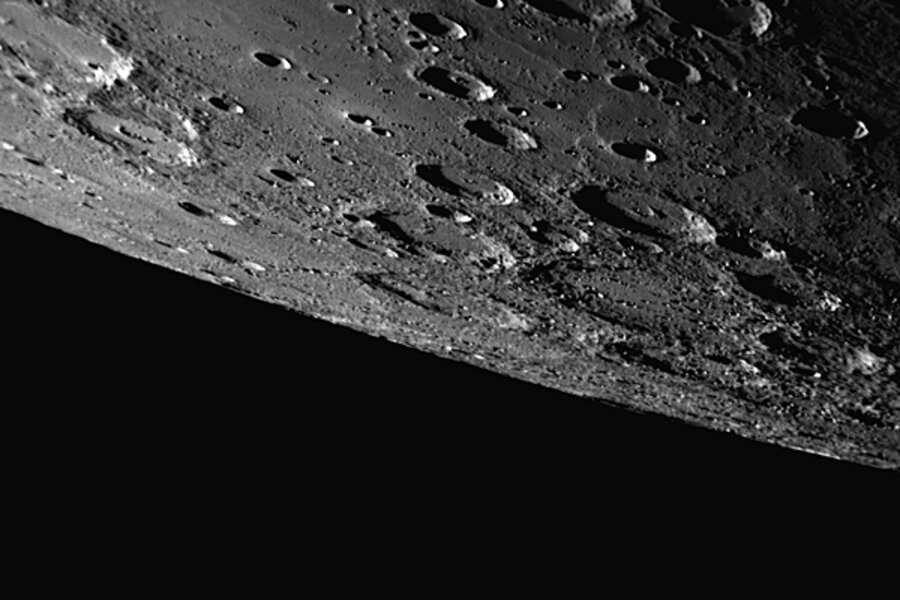NASA milestone: MESSENGER spacecraft enters orbit around Mercury
Loading...
In the 50-year history of solar-system exploration, instrument-loaded orbiters have circled Earth, Mars, the moon, and Venus, as well as giant planets Jupiter and Saturn.
Tiny Mercury, however, long had been excluded from the itinerary as just too tough a mission to pull off – until now.
At 9:10 Eastern time Thursday night, controllers overseeing the NASA MESSENGER mission to Mercury saw the first evidence that their spacecraft had safely inserted itself into orbit around the first rock from the sun.
The news met with an eruption of cheers and handshakes from the mission operations center at the Johns Hopkins University's Applied Physics Laboratory in Laurel, Md., which built the craft.
"You only go into orbit for the first time around Mercury once in human history, and that's what we've done tonight," said Edward Weiler, the National Aeronautics and Space Administration's associate administrator of the Science Mission Directorate, who was on hand as the mission achieved the crucial milestone.
Twelve years ago, the project existed only as PowerPoint slides and charts, he said. Now, the team has added Mercury as the sixth planet to come under the scrutiny of an instrument-laden artificial satellite.
"We're all a little sleep deprived, but it's tremendously exciting" to see the craft safely in orbit, said the the mission's lead scientist, Sean Solomon, Friday morning. Dr. Solomon is a planetary scientist at the Carnegie Institution for Science in Washington.
The only other mission to take Mercury's measure was NASA's Mariner 10, which conducted three flybys of the planet in 1974.
Despite its relative dearth of robotic visitors, the planet is of keen interest to scientists studying the solar system and its evolution.
Mercury is the smallest planet, yet for its size, it's thought to have an enormous iron core – accounting for 60 percent of the planet's mass, compared with some 30 percent for Earth's core. Far more of Mercury's core is thought to be solid, compared with Earth's.
Although Mariner's results sparked interest in sending an orbiter, Mercury has languished on the solar-system-exploration agenda in large part because of its extreme environment, which a spacecraft must endure.
At some 36 million miles from the sun, temperatures on the planet's daylight half hit 800 degrees F., while temperatures on the night half plunge to nearly minus 300 degrees F. – a 1,100-degree temperature swing that the craft will experience every 12 hours.
The craft is outfitted with a ceramic-cloth sun shield that sheds enough of the sun's heat to keep instruments inside the orbiter at room temperature. Solar panels, which ordinarily would aim face-on to the sun, must be feathered, like a rowboat oar, to keep the panels from overheating. In addition, the panels contain mirrors to help shed some of the intense sunlight.
The business side of the craft, which will be facing the planet's roasting surface on the sunlit side, also requires a cool-down. Thus the craft's orbit will take it to within 124 miles of the surface on the sunlit side and out to just over 9,000 miles on the night side for cooling. Also on that side, the craft will take measurements of the space environment in Mercury's immediate vicinity.
MESSENGER is expected to help provide an explanation for the planet's structure, in addition to gathering detailed information on the topography and composition of its surface.
One intriguing mystery involves odd signatures from Earth-based radar observations of crater floors at Mercury's poles. The bottoms of these craters are in permanent shadow, similar to craters at the moon's poles. On the moon, those crater floors have been shown to contain relatively high abundances of water ice. With Mercury's polar craters returning radar signatures similar to those from other, well-known icy regions on Mars or on Jupiter's moons, scientists are eager to see if Mercury also might have frigid reservoirs of water ice, despite its proximity to the sun.
The MESSENGER craft will undergo about two weeks of commissioning, where scientists will test their instruments in a true Mercury environment.
After that, "the fun begins," Solomon says, anticipating a stream of intriguing results that will have the science team "drinking from a fire hose."





